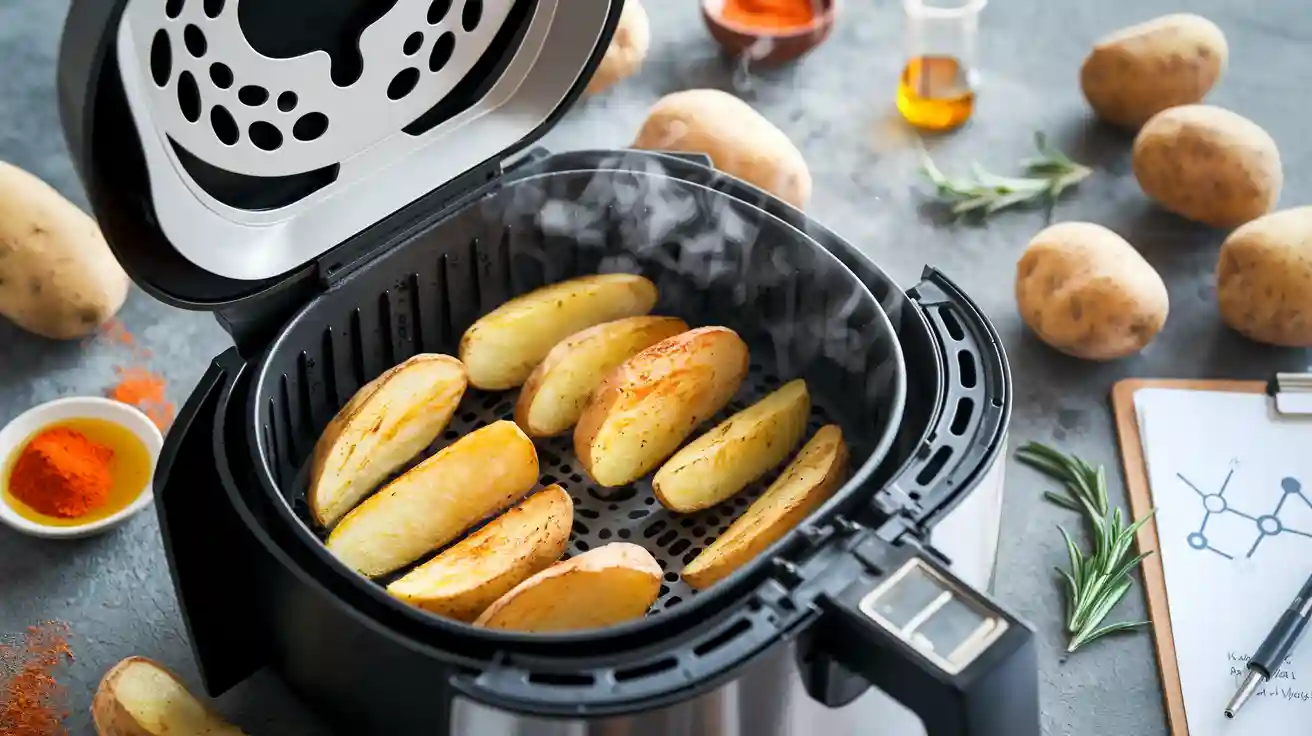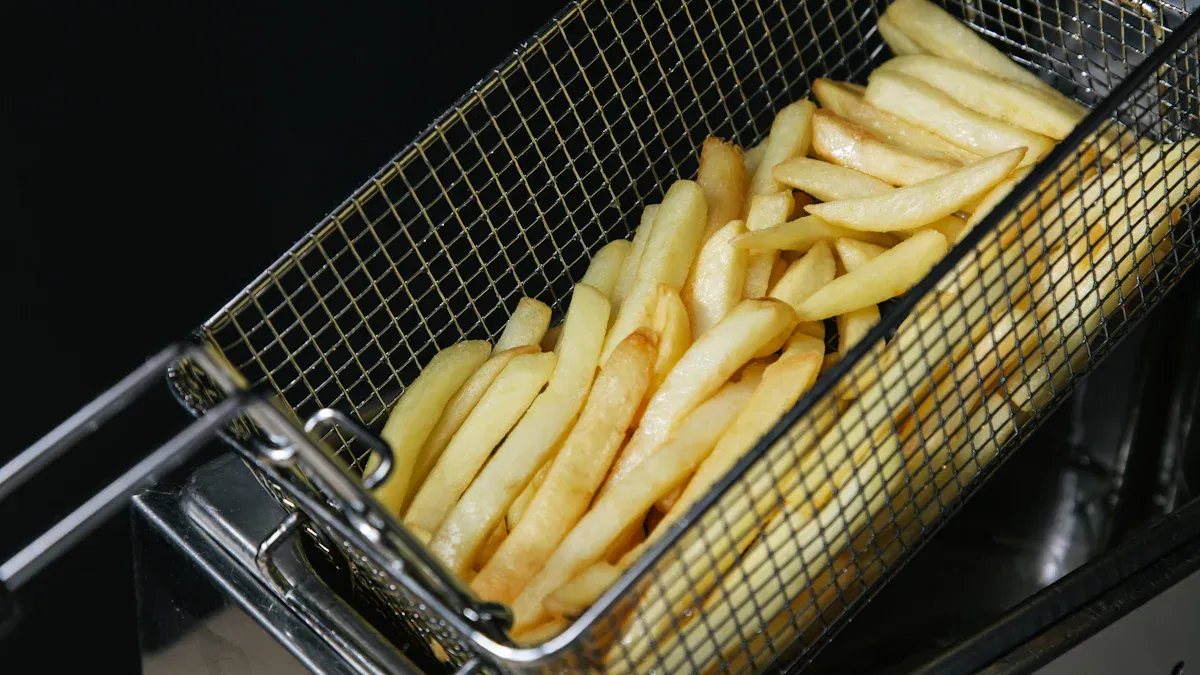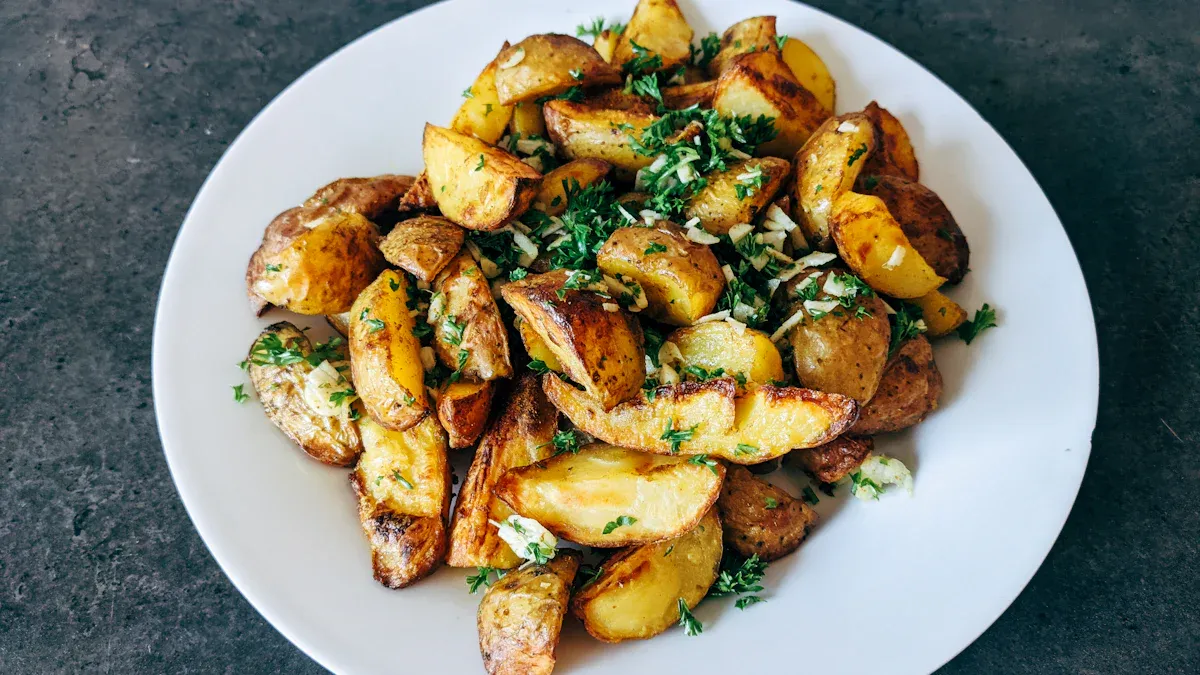
Have you ever wondered why air fryer potatoes taste so good? Air fryers don’t just cook—they transform. By using science, they create crispy, golden potatoes with less oil. This isn’t magic; it’s technology at work. But what makes these potatoes so special? Let’s dive into the secrets behind their perfection.
How Air Fryers Work
Rapid Air Technology and Heat Circulation
Air fryers rely on rapid air technology to cook food quickly and evenly. This technology uses high-speed air circulation to transfer heat uniformly. Imagine a mini convection oven working overtime to surround your food with hot air. The result? Your potatoes get crispy on the outside while staying fluffy inside.
Here’s a quick look at how air fryers have improved over time:
| Feature | Original Specification | Improved Specification |
|---|---|---|
| Motor Type | DC Brush Motor | Optimized Motor |
| Lifespan | 100-150 hours | Extended Lifespan |
| Noise Level | 75 dBA | 60 dBA |
| User Experience | Poor | Enhanced |
This advanced design ensures your air fryer potatoes cook evenly, with consistent quality every time. The hot air, often reaching around 200 °C, dehydrates the surface of the potatoes, forming a golden crust. Plus, the cooking time is much faster—up to 50% shorter than traditional methods.
Mimicking Frying Without Excess Oil
Air fryers give you the crispy texture of fried food without the guilt. Instead of dunking your potatoes in oil, the air fryer uses forced hot air to create a similar effect. This method requires 50–70% less oil than deep frying, which means your potatoes have lower fat content but still taste amazing.
The high heat and rapid air circulation also reduce harmful compounds like acrylamide by up to 90%. So, not only are you cutting down on calories, but you’re also making a healthier choice for your body. With air fryers, you can enjoy the sensory experience of fried potatoes—crunchy, golden, and delicious—without the heavy oil.
The Science Behind Air Fryer Potatoes

The Maillard Reaction and Browning
Have you ever noticed how air fryer potatoes develop that irresistible golden-brown color? That’s the Maillard reaction at work. This chemical process happens when heat causes amino acids and sugars in the potatoes to react, creating new flavors, aromas, and that signature browning. It’s why your potatoes don’t just look good—they taste amazing too.
Air frying optimizes this reaction by maintaining high temperatures and circulating hot air evenly. Research shows that air frying can reduce harmful compounds like acrylamide, which forms during high-heat cooking. For example, studies found that air-fried potatoes contain significantly lower acrylamide levels (91 ± 13 μg/kg) compared to deep-fried ones (126 ± 15 μg/kg). This means you get all the flavor and crunch without the same health risks.
Here’s a quick comparison of acrylamide levels in different foods to give you some perspective:
- Potato chips: 211–3515 μg/kg
- French fries: 779–1299 μg/kg
- Pan-fried potatoes: 450 μg/kg
So, the next time you bite into a crispy air-fried potato, you’ll know it’s not just delicious—it’s a little healthier too.
Achieving Crispiness Through Hot Air Circulation
Crispiness is what makes air fryer potatoes so satisfying. But how does an air fryer achieve that perfect crunch? It’s all about hot air circulation. The rapid airflow removes moisture from the surface of the potatoes, creating a dry, crispy exterior while keeping the inside soft and fluffy.
Studies have shown that higher airflow velocities enhance moisture loss, which is key to achieving that crunch. Here’s a breakdown of how airflow impacts crispiness:
| Finding | Description |
|---|---|
| Airflow Velocity | Faster airflow speeds up moisture loss, leading to a crispier surface. |
| Surface Characteristics | Increased airflow creates more surface wrinkles and porosity, enhancing texture. |
| Acrylamide Formation | Uniform airflow reduces acrylamide accumulation, ensuring safer cooking. |
This process is why air fryers are so effective. They don’t just cook your potatoes—they transform them into crispy perfection. And the best part? You don’t need a ton of oil to get there.
Texture Transformation: Gelatinization and Pectin Breakdown
The magic of air fryer potatoes doesn’t stop at crispiness. Their texture also changes in fascinating ways during cooking. Two key processes—starch gelatinization and pectin breakdown—are responsible for this transformation.
When you cook potatoes, the heat causes the starch granules to absorb water and swell. This is called gelatinization, and it’s what makes the inside of your potatoes soft and creamy. At the same time, the heat breaks down pectin, a natural substance that holds the potato cells together. This breakdown allows the cells to separate, giving the potatoes a tender, fluffy texture.
Here’s a closer look at these processes:
| Process | Description |
|---|---|
| Starch Gelatinization | Heat causes starch granules to swell, creating a soft, creamy interior. |
| Pectin Breakdown | Pectin dissolves, leading to cell separation and a tender texture. |
| Temperature Effects | Pectin starts breaking down above 60°C, while starch gelatinization occurs during cooking. |
These changes happen simultaneously, thanks to the air fryer’s precise temperature control and efficient heat transfer. The result? Potatoes that are crispy on the outside, soft on the inside, and absolutely delicious.
Health and Practical Benefits of Air Fryer Potatoes
Reduced Oil and Fat Content
Air fryer potatoes are a game-changer for anyone looking to cut back on fat without sacrificing flavor. Unlike deep frying, which requires large amounts of oil, air frying uses just a tablespoon—or sometimes none at all. This means your potatoes absorb up to 80% less oil, making them a healthier option.
Take a look at how air frying compares to traditional frying:
| Cooking Method | Oil Required | Fat Reduction |
|---|---|---|
| Deep Frying | Up to 3 cups (750 mL) | Baseline |
| Air Frying | About 1 tablespoon (15 mL) | Up to 75% less fat |
This reduced oil absorption doesn’t just lower fat content—it also helps manage cholesterol levels and decreases the risk of cardiovascular disease. Air-fried potatoes contain approximately 7.9 grams of fat per cup, significantly less than their deep-fried counterparts. So, you can enjoy crispy, golden potatoes without the guilt.
Tip: Using less oil doesn’t mean compromising on texture. The air fryer’s rapid circulation ensures your potatoes stay crunchy on the outside and soft on the inside.
Nutrient Retention in Air Frying
Air frying isn’t just about cutting calories—it’s also about preserving nutrients. The hot air circulation technology helps retain essential vitamins and antioxidants like ascorbic acid and phenolic substances. This means your air fryer potatoes aren’t just tasty; they’re packed with nutrients that your body needs.
Here’s why air frying stands out:
- It preserves more nutrients compared to deep frying, including antioxidants that fight free radicals.
- Air-fried potatoes contain lower levels of harmful compounds like acrylamide and hydroxymethylfurfural (HMF), which are linked to health risks.
- The reduced oil absorption ensures fewer calories while maintaining the potato’s natural flavors.
Air frying also minimizes the formation of Maillard hazards, which can occur during high-heat cooking. This makes it a safer and healthier choice for preparing your favorite potato dishes.
Note: Air-fried potatoes are not only better for your health but also for your taste buds. They retain their natural sweetness and earthy flavor, making every bite satisfying.
Faster Cooking and Convenience
Time is precious, and air fryers help you save plenty of it. Cooking potatoes in an air fryer takes about 30 to 40 minutes, compared to nearly an hour in a traditional oven. Plus, air fryers preheat in just 4 minutes, while ovens can take up to 25 minutes.
Here’s a quick comparison of cooking times:
- Air fryer potatoes: 30–40 minutes (including preheating).
- Oven-baked potatoes: 50–60 minutes (plus 25 minutes for preheating).
This efficiency makes air fryers perfect for busy weeknights or last-minute meals. You can whip up crispy, golden potatoes in less time, without compromising on quality.
Callout: Air fryers aren’t just fast—they’re easy to use. With simple controls and minimal cleanup, they’re a practical addition to any kitchen.
Whether you’re cooking for one or feeding a crowd, air fryers make it easy to enjoy delicious potatoes without the hassle.
Tips for Perfect Air Fryer Potatoes

Selecting the Best Potato Variety
Not all potatoes are created equal, especially when it comes to air frying. For the best results, choose varieties with low sugar content and a high starch level. Potatoes like Colomba, with reducing sugar levels below 0.30%, are ideal for frying. Agria potatoes are another excellent choice, often used in commercial products for their consistent texture and flavor. These varieties crisp up beautifully while maintaining a fluffy interior.
Tip: Avoid waxy potatoes like red or fingerling varieties. They don’t crisp as well and may turn out too soft.
Prepping Potatoes: Soaking and Seasoning
Preparation is key to achieving perfect air fryer potatoes. Start by cutting your potatoes into small, uniform pieces—about ¼ to ⅜-inch thick. This ensures even cooking and crispiness. Soak the slices in cold water for 30 minutes to remove excess starch, which helps them crisp up better. After soaking, pat them dry with a clean towel.
When it comes to seasoning, toss the potatoes with a light coating of oil and your favorite spices. Paprika, garlic powder, and a pinch of salt work wonders. Don’t overdo the oil—a tablespoon is plenty for a whole batch.
Callout: Drying the potatoes thoroughly after soaking prevents sogginess and helps the seasoning stick better.
Optimal Temperature and Cooking Times
Getting the temperature and timing right is crucial. Set your air fryer to 400°F (200°C) for the best results. Cook the potatoes for 35 to 40 minutes, flipping them halfway through to ensure even browning. If your fries aren’t crisping up as you’d like, increase the temperature slightly or extend the cooking time by a few minutes.
Pro Tip: Keep an eye on your potatoes during the last 5 minutes of cooking. They can go from perfectly golden to overdone quickly.
Avoiding Overcrowding for Even Cooking
Resist the urge to fill your air fryer basket to the brim. Overcrowding blocks hot air circulation, leading to uneven cooking. Arrange the potatoes in a single layer with some space between them. If you’re making a large batch, cook in multiple rounds for consistent results.
Reminder: Think of your air fryer as a mini convection oven. Proper spacing ensures every piece gets that perfect crispy texture.
Air fryer potatoes are a perfect blend of science and flavor. They owe their crispy texture and golden color to two key principles: rapid air technology and the Maillard reaction.
- Rapid air technology circulates hot air around the potatoes, ensuring even cooking with minimal oil.
- The Maillard reaction creates the browning and rich flavors that make every bite irresistible.
This method doesn’t just deliver delicious results—it’s healthier and faster too. With less oil, fewer harmful compounds, and shorter cooking times, air frying is a win for your taste buds and your schedule.
So, why not give it a try? Experiment with different potato varieties, seasonings, and techniques. Your next batch of air fryer potatoes might just be your best yet!
FAQ
1. Can you use frozen potatoes in an air fryer?
Yes, you can! Frozen potatoes cook beautifully in an air fryer. Just adjust the cooking time slightly and shake the basket halfway through.
Tip: Preheat your air fryer for the best results with frozen potatoes.
2. Why do my air fryer potatoes turn out soggy?
Overcrowding is the main culprit. Arrange potatoes in a single layer to allow proper air circulation. Also, dry them thoroughly before cooking.
3. Do you need to preheat an air fryer for potatoes?
Preheating isn’t always necessary, but it helps achieve crispier results. If your air fryer has a preheat function, use it for even cooking.
Note: Preheating usually takes just 3–5 minutes, so it’s quick and easy!


